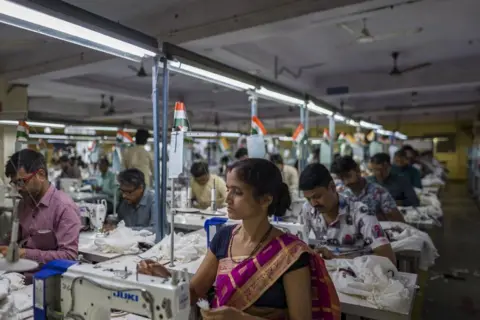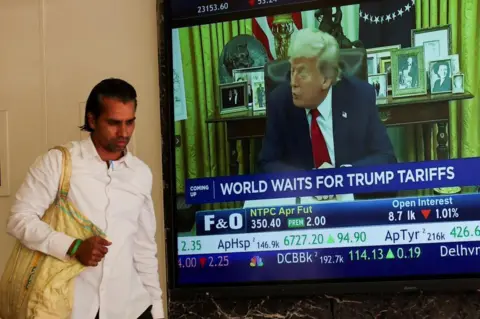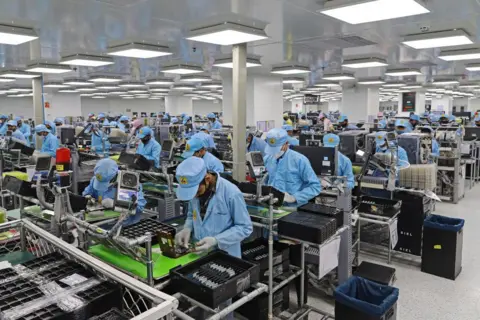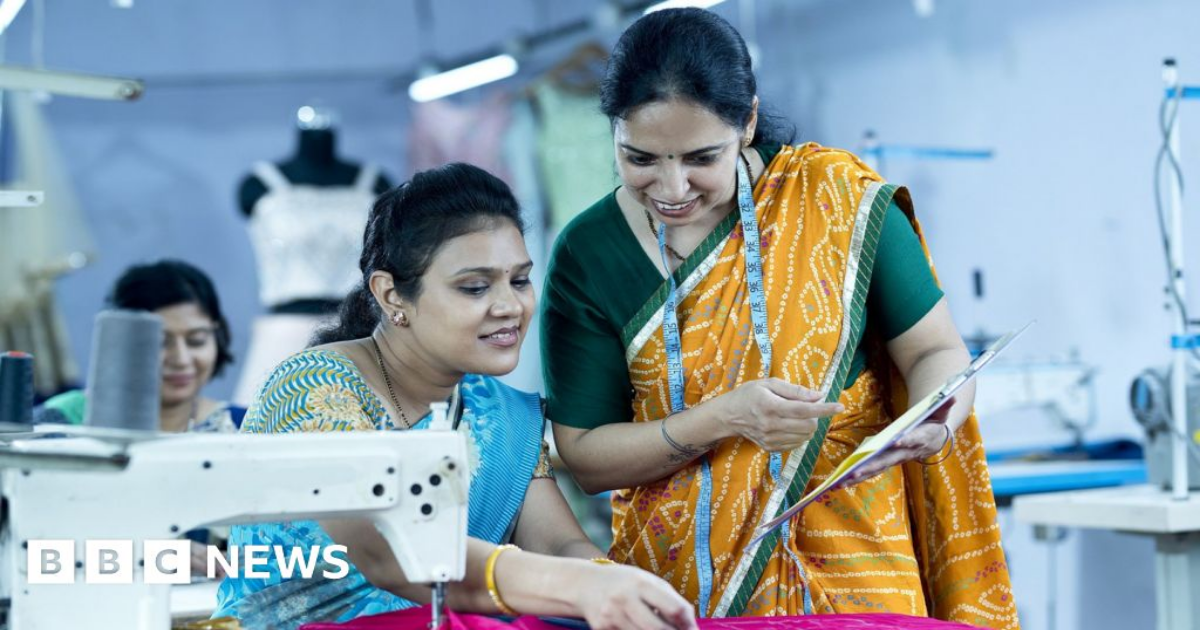Soutik Biswas
India correspondent•@soutikBBC

 Getty Images
Getty Images
High tariffs on China and Bangladesh can help Indian textile manufacturers to expand in the US market
Donald Trump’s sweeping tariffs have shaken global trade, but disruption often creates opportunity.
Starting 9 April, Indian goods will face tariffs of up to 27% (Trump’s tariff chart lists India’s rate as 26%, but the official order says 27% – a discrepancy seen for other nations too). Before the tariff hike, US rates across trading partners averaged 3.3%, among the lowest globally, compared to India’s 17%, according to the White House.
However, with the US imposing even higher tariffs on China (54%), Vietnam (46%), Thailand (36%) and Bangladesh (37%), India “presents an opportunity” in textiles, electronics and machinery, according to the Delhi-based think tank Global Trade Research Initiative (GTRI).
High tariffs on Chinese and Bangladeshi exports open space for Indian textile manufacturers to expand in the US market. While Taiwan leads in semiconductors, India can tap into packaging, testing and lower-end chip manufacturing – if it strengthens infrastructure and policy support. Even a partial supply chain shift from Taiwan, driven by 32% tariffs, could work in India’s favour.
Machinery, automobiles and toys – sectors led by China and Thailand – are ripe for tariff-driven relocation. India can capitalise by attracting investment, scaling production and boosting exports to the US, according to a note by GTRI.
But will India be able to seize the moment?
High tariffs have increased costs for companies dependent on global value chains, hobbling India’s ability to compete in international markets. Despite growing exports – primarily driven by services – India runs a significant trade deficit. India’s share of global exports is a mere 1.5%. Trump has repeatedly branded India a “tariff king” and a “big abuser” of trade ties. With his new tariffs, the fear is that Indian exports will be less competitive.

 Reuters
Reuters
Starting 9 April, Indian goods will face tariffs of up to 27%.
“Overall, the US’s protectionist tariff regime could act as a catalyst for India to gain from global supply chain realignments,” says Ajay Srivastava of GTRI.
“However, to fully leverage these opportunities, India must enhance its ease of doing business, invest in logistics and infrastructure and maintain policy stability. If these conditions are met, India is well-positioned to become a key global manufacturing and export hub in the coming years.”
That’s easier said than done. Biswajit Dhar, a trade expert from the Delhi-based Council for Social Development think tank, points out that countries like Malaysia and Indonesia are possibly better positioned than India.
“We may regain some lost ground in garments now that Bangladesh faces higher tariffs, but the reality is we’ve treated garments as a sunset sector and failed to invest. Without building capacity, how can we truly benefit from these tariff shifts?” says Mr Dhar.
Since February, India has ramped up efforts to win Trump’s favour – pledging $25bn in US energy imports, courting Washington as a top defence supplier and exploring F-35 fighter deals. To ease trade tensions, it scrapped the 6% digital ad tax, cut bourbon whiskey tariffs to 100% from 150% and slashed duties on luxury cars and solar cells. Meanwhile, Elon Musk’s Starlink nears final approval. The two countries have launched extensive trade talks to narrow the US’s $45bn trade deficit with India.
Yet, India did not escape the tariff war.
“India should be concerned – there was hope that ongoing trade negotiations would shield it from reciprocal tariffs. Facing these tariffs now is a serious setback,” says Abhijit Das, former head of the Centre for WTO Studies at the Indian Institute of Foreign Trade.

 Getty Images
Getty Images
Exports in key sectors like electronics and engineering goods could take a hit from the new tariff plan
One upside: pharmaceuticals are exempt from reciprocal tariffs, a relief for India’s generic drug makers. India supplies nearly half of all generic medicines in the US, where these lower-cost alternatives account for 90% of prescriptions.
However, exports in key sectors like electronics, engineering goods – automobile parts, industrial machines – and marine products could take a hit. It would be especially troubling for electronics, given the heavy investments through India’s flagship “production-linked incentives” (PLI) schemes to boost local manufacturing.
“I’m apprehensive about our exporters’ capacity – many are small manufacturers who will struggle to absorb a 27% tariff hike, making them uncompetitive. High logistical costs, rising business expenses and deteriorating trade infrastructure only add to the challenge. We’re starting at a major disadvantage,” says Mr Dhar.
Many see these tariffs as Trump’s bargaining chip in trade negotiations with India. The latest US Trade Representative report underscores Washington’s frustration with India’s trade policies.
Released on Monday, the report flags India’s strict import rules on dairy, pork and fish, requiring non-GMO certification without scientific backing. It also criticises India’s sluggish approval process for genetically modified products and price caps on stents and implants.
Intellectual property concerns have landed India on the ‘Priority Watch List’, for which the report cites weak patent protections and a lack of trade secret laws. The report also frets about data localisation mandates and restrictive satellite policies, straining trade ties further. Washington fears India’s regulatory approach is increasingly mirroring China’s. If these barriers were removed, US exports could rise by at least $5.3bn annually, according to the White House.
“The timing couldn’t be worse – being in the middle of trade negotiations only deepens our disadvantage. This isn’t just about market access; it’s the whole package,” says Mr Dhar. Also, gaining an edge over Vietnam or China won’t happen overnight – building opportunities and competitive strength takes time.
